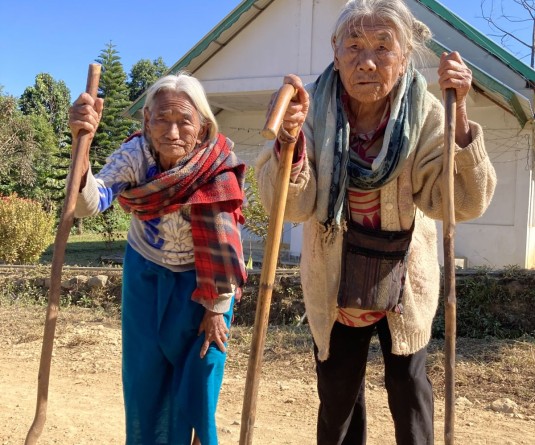
Total monthly rainfall received in Dimapur district during June month was 153.9 mm, 33% less than the normal. The number of rainy days for the month of June was 13. From January to May 2022, rainfall received was 46% more than the normal.
Plant Breeding & Genetics – Harendra Verma
1. Uproot the seedling age of 21-25 days and transplant only healthy seedling per hill.
2. Treat the roots of the seedling with solution of bavistin fungicide having concentration of 0.4% to avoid occurrence of bakane disease and other fungal disease.
3. Treat the roots of seedling with solution of chlorocyper insecticide (0.4%) to avoid attack of termites.
4. Do transplanting by maintaining a distance of 30cm row to row and 10cm plant to plant to facilitate proper air circulation and to avoid incidence of disease and pest.
5. For late sowing, farmers are advised to go for raising of nursery with RC-Maniphou 7 variety.
6. Mix well dry decomposed compost before last puddling to realise higher yield.
Soil Science – Rokozeno Chalie-u & Christy BK Sangma
1. Ensure the availability of biofertilizers for soybean. Apply rhizobium + PSB at 25g/kg seed, Trichoderma @4g/kg of seed.
2. Line sowing and maintain spacing is recommended for soybean
3. In situ moisture conservation by mulching.
4. Rain water is also encouraged.
Agroforestry – Pempa Lamu Bhutia
* Planting should be done as soon as the rains have fully set in and the soils are soaked to a depth of 30 cm. Plantation activity in area at an altitude above 1500 m can be done in May-June also. In areas where monsoon rains are very heavy, planting should be done before or after the wettest period of monsoon.
* Planting should be done usually on a gloomy day. This optimum condition may not prevail when the planting is done over an extensive area. Therefore, efforts should be made to complete the work as early as possible once it is started.
* Planting Techniques:
Entire planting with naked roots: Pit size should be sufficient enough to contain the entire root system without bending the tap root. Plants should be held in a vertical position by the collar in the centre of the pit. Collar should be kept about 10 cm above the ground level so that the seedlings come to ground level when the soil is pressed, or subsides due to rain water. Transplant should be covered upto the collar keeping the soil sloping in all directions. Soil should be well pressed leaving no interspaces inside. Care should be taken that no parts of root remains exposed and no part of shoot gets buried in the soil.
Seedlings with ball of earth: Pit size should be big enough to contain the ball plant. While planting, grass or any leaves used for wrapping the ball should be removed first. If the depth of the pit is too big, then pit should be filled up with dug up earth to a level when the seedlings is placed in it, it should be about 5 cm above the general ground level. After filling the earth, it should be pressed well with hands.
Plants raised in polybags: These plants should be irrigated before being dispatched from nursery. Planted in the same way as ball plants.
Stump planting: Stumps are prepared from the nursery raised seedlings. Only those seedlings are made into stumps which have a single tap root of length not less than 30 cm. Collar diameter is an indication of thickness of roots, is also very important parameters to be taken into consideration. Stumps are planted in the field either in holes made by planting crowbar or some sharp stick, or in pits of 30 cm diameter and 30 cm in height. Hole should not be made deeper than the root of the stump or else some space left at the bottom results in drying of the lower portion of the stump. The stump is held 1 cm above the ground level and lose earth is filled in from all sides of the stump. Crowbar holes should not be made in heavier soils as it compacts the wall of the holes.
Poultry –Mahak Singh and Talimoa
1. Since it is a season of high temperature and humidity, deep litter material could get wet and not dry up. Therefore running a ceiling fan can enhance air circulation and maintaining dry deep litter.
2. Mixing a bit of turmeric powder in the feed can enhance the immunity of birds. It can be added at 0.5-2.0% of total feed and given 2-3 days from time to time.
3. Provide vitamins and electrolytes in water when the weather conditions become extreme.
4. Check the conditions of the flock in each pen atleast twice daily and isolate sick birds for treatment.
5. Vaccination and deworming should be carried out on schedule. New castle disease vaccine, IBD Vaccine and fowl pox vaccine are important for poultry.
6. While broiler birds may be fed continuously, layers should be kept on limited feeding.
Piggery – Mahak Singh and Talimoa
1. Disinfect the sheds daily after cleaning and rinsing with water. Potassium permanganate or chlorine based chemicals may be used.
2. Pigs should be provided balanced ration. Many local farmers are providing protein deficient ration. They may increase the protein content by using soya cake meal, groundnut cake meal or fish meal.
3. Pregnant animals should be taken care of properly by taking first hand advice from a competent veterinarian.
4. Sows have a pregnancy period of 114 days and farrow by 115th day. If it gets delayed, immediately consult a veterinarian.
5. Maintain biosecurity and invest in the right disinfectant chemicals.
6. Vaccination and deworming should go on schedule.




